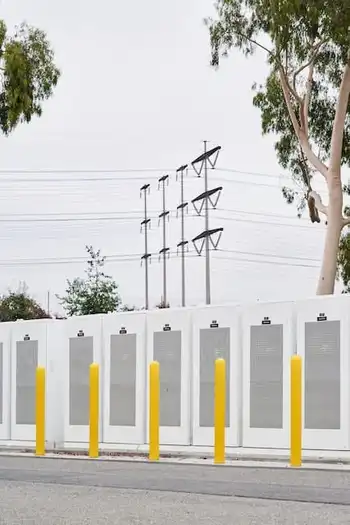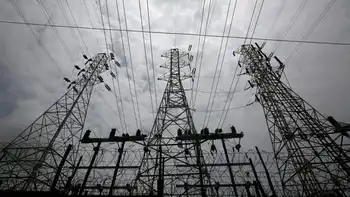$2 billion in upgrades proposed
By Portland Press Herald
CSA Z463 Electrical Maintenance -
Our customized live online or in‑person group training can be delivered to your staff at your location.

- Live Online
- 6 hours Instructor-led
- Group Training Available
The projects are designed to prevent blackouts and would create thousands of construction jobs. But they also will impact thousands of abutters, require the acquisition of hundreds of land parcels and increase electric bills.
Central Maine Power Co. has filed petitions for permits to overhaul's the state's bulk power grid, in what would become one of the state's largest construction projects. The company would spend $1.4 billion to widen the existing power line corridor along a 370-mile path from Orrington, just south of Bangor, to Newington, N.H. The company would add 345,000-volt transmission lines and other equipment.
Central Maine Power and Maine Public Service Co. also would spend $625 million to build a new 200-mile corridor with a 345,000-volt transmission line from central Maine to northern Aroostook County to connect with wind farms being developed in that area.
Without the upgrades, said company officials, Mainers can expect possible power disruptions in the future.
"We see 2012 as a critical year if loads continue to grow," said John Carroll, Central Maine Power spokesman.
Dozens of organizations have lined up to take part in the Public Utilities Commission permitting process, including municipalities, business groups, homeowners, environmental agencies and the Office of the Public Advocate, which will be looking out for utilities' customers. Winning approval will clear the way for the power companies to take the land by eminent domain.
Public Advocate Richard Davies said his office has already hired a team of consulting engineers who have experience with transmission line projects. Central Maine Power is pushing for the upgrades after a study determined that the 37-year-old existing bulk transmission system would soon be inadequate to carry Maine's power needs.
The bulk transmission system operates like the interstate highway system, carrying electricity from generating plants to areas where large amounts of electricity are needed. From there, distribution lines carry the electricity to where it is used.
The company says the state's population and its sources of electricity generation have shifted since the system was last upgraded, making the improvements necessary. More people have moved into southern Maine, while power generators have become more distant and dispersed, especially with the closing of the Maine Yankee plant.
Central Maine Power is asking ISO New England, the private body that oversees New England's electrical grid, to help share the cost. But before that can happen, the company must prove that the rest of New England would benefit from the upgrade.
If that request is approved, an action CMP officials anticipate, Maine ratepayers would pay for only 8 percent of the project. CMP was unable to provide more information about the impact on Maine electricity bills.
If approved, the massive construction project would begin in the winter of 2010 and continue for about two years. Some 8,000 jobs would be created. The southern leg of the project would require Central Maine Power to acquire 550 parcels of land, most of them 50 to 100 feet wide, in order to broaden existing corridors. In all, 4,500 abutters will be impacted by either the southern or northern sections of the project.
About 3,100 acres of land would be cleared to make way for the 75-foot-tall utility poles that would carry the new lines along the northern corridor. CMP did not have information available on how many acres would be cleared along the southern corridor.
CMP plans to double the number of its system's primary transformers - which function like highway exits on the power grid -- to 10. Fifteen new substations would also be built.
The regulatory process is equally complex. The Public Utilities Commission will hold court case-like proceedings involving sworn testimony to decide whether there is a need for the project and whether the benefits to Central Maine Power customers outweigh the costs. There will be various yet-to-be-scheduled hearings around the state. That process is expected to start in the fall.
The project also will require permits from the state Department of Environmental Protection and from 120 cities and towns. Central Maine Power has yet to file for those permits.
As part of the regulatory process, Central Maine Power is required look for alternatives to transmission lines to satisfy power needs, such as conservation measures to cut the demand or new generators closer to the transmission system. This is required because Central Maine Power makes money solely on the transmission system. The company may charge ratepayers up to 12.5 percent of the value of the system.
"The net effect is the more transmission, the more they can charge 12.5 percent (on their equipment.) If I were in their situation, I would be looking at the same thing," said Davies.
So far, the project is being viewed favorably by some in the business community.
The Associated General Contractors of Maine, which has 250 members, backs the proposal because it will ensure an affordable electrical supply and create thousands of construction jobs, said John O'Dea, communications director.
"To have somebody lining up to make an investment in Maine is exactly what we have all been asking for," said O'Dea.
Some environmental groups say they will be involved in the regulatory process. The Conservation Law Foundation is interested in the project because it would increase the state's capacity to generate cleaner energy sources, such as wind energy generators, said Sean Mahoney, vice president. He said the foundation will be trying to ensure that viable alternatives to transmission lines are considered during the regulatory process.
Dozens of homeowners along the corridors have signed up for intervenor status so they can testify in the PUC approval process.
Roberta Beavers of South Berwick said she is concerned about plans to widen the power line corridor through her Woodland Hills condominium complex and its impact on home values, health and quality of life.
"High voltage is not good for the health of small children and the elderly," she said. Beavers said she wants the corridor to be buried as it runs through her development, just like the transmission lines in York that were buried several years go to protect the view.
Carroll predicted the permitting process will be lengthy and time consuming and will test the public's resolve to create cleaner energy sources and control energy costs.
"It is a test of our political will. Do we really believe in the policies we are talking about?" he said.











